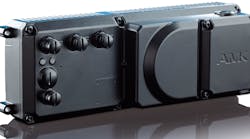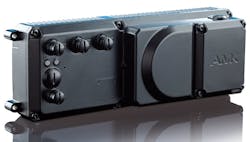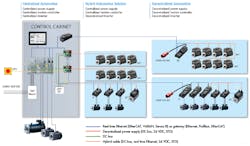In today’s automated machines and platforms, the controllers, drives, and servomotors that move these machines are simultaneously the “brains” and “muscle” of automated production. As the technology of machine motion has evolved, more and more intelligent electronics have been incorporated to control and drive individual machine axes. Consequently, the size and complexity of the control cabinet has become the “axis” around which the rest of the system is designed.
This development can create constraints on OEMs, systems engineers, and end users. Costs associated with control cabinets regularly increase, particularly as more complex automation designs are developed with increased numbers of servo-driven axes. And because the control cabinet is relatively “fixed” to its location on the production floor, it limits the ability of manufacturers to modify and update their production footprint to satisfy changing consumer demands, product mixes, and productivity improvements.
A new generation of motion control and servo-drive technology is rapidly gaining acceptance in the automation world: “cabinet-free,” or distributed, control and drive systems. These systems give OEMs and systems designers the freedom to locate servo drives, controllers, and power supplies on or near motors and the axes they drive, simplifying multiple engineering, cabling, and installation challenges.
Evolution of Drives and Controls
Machine drives and controls have gone through at least three generations. The first generation, Gen 1, could be considered the electromechanical era. A single large electric motor, without any intelligent control, powered a large central machine shaft. This master shaft drove all of the remaining machine axes through various transfer devices, such as gearboxes, cam shafts, and push arms.
This decentralized motion controller performs the complete control of a machine segment and can be used as a gateway to higher-level controllers. For automation completely free of control cabinets, an integrated incoming supply generates the dc voltage for connected servo axes.
When the mechanical engineer designing the system had to determine how much power was needed to drive a machine with a dozen lever arms, the task was very simple: Add up the load and motion frequency required to power the motion of each axis. The result was usually a motor within the 20- to 30-horsepower range.
In Gen 1 systems, motion logic was engineered through the mechanical gearboxes and other physical transfer devices. The downside of this approach, as is well-known, is that these mechanical devices underwent a lot of wear and tear. They needed significant maintenance and replacement schedules and were highly inflexible; changeovers from one size of product or packaging to another required a machine shutdown so that mechanics could implement physical changes to the gearing.
The second generation of machine motion control could be considered “hybrid” solutions—half the motion and control was provided through electronic servomotors; the rest was provided by mechanical control machines. These Gen 2 hybrid machines began replacing a single machine line shaft with separate motors driving specific machine axes and motion sequences. In essence, the one, large 30-hp motor was broken down into smaller motors. It also led to replacing gearboxes and other mechanical motion-control devices with servo drives controlling the motors. The motion sequences of these multiple servo motors were in turn synchronized by the PLC or motion controller, which also handled other higher machine functions.
The shift to the third generation of motion control completed the evolution from mechanical line shafts to pure servo technology. As a result, Gen 3 machines moved the complexity of the machine’s design from mechanical to electronic components. Each servo motor needs a drive module and power supply, and had to have both power and communications cabling.
Managing and integrating all of these elements, including bus interfaces and input/output devices, led to centralizing all of these devices in the control cabinet. When motor controls became a focal point of machine design, the size of electrical cabinets grew, sometimes becoming as large as the machine mechanic.
There are industry trends in place to reduce the machine cabinet to pre-Gen 2 machine designs. This is possible using the newest portfolio of systems now available for implementing distributed drive-and-control architectures. Such solutions are theoretically “cabinet-free” and potentially represent the next evolution of drive systems for automation.
Cabinet-Free Technology Challenges Design Assumptions
As each generation evolved from one to the next, system designers have been challenged to reorient their thinking to maximize use of a new technology’s inherent advantages. For example, it was common early on (and, in some cases, is still common) for designers to attempt to drive multiple machine components with one servo motor.
Unfortunately, this “stacking” approach, while it reduces the servo motor and drive count, forces the designer to specify a larger power motor to handle the load along with a myriad of mechanical components to deliver the centralized power. A more effective approach is to divide the machine mechanics into better logical components.
One common example of this setup is a Cartesian motion system used in palletizing applications. Some designers mount a single large motor with gearbox or pulley on top of the carriage to power both sides of the X-axis motion. While this reduces the component count and theoretically simplifies the control, the design adds significant weight to the carriage. The drive and motor must then be sized to handle moving not only the weight of the products being palletized, but also the entire drive and motor assembly mounted on the carriage.
Having separate servo motors for each axis mounted on the system frame and separately driving the X-axis motion of the system reduces the power requirements, enables the use of smaller motors, and makes for a more efficient solution.
As a common practice to try and simplify machine control, many designers attempt to drive multiple machine components with one servo motor. Unfortunately, this “stacking” approach forces the designer to specify a larger motor to handle the load, along with many mechanical components to deliver the centralized power.
Another reason some systems designers resist adding servo motors is PLC limitations. Some PLC suppliers limit the axis count supported by one PLC to 16 or 32 axes, requiring the purchase of a second PLC (or a more expensive box with higher capacity). This preference for limiting servo motors is another barrier to more widespread acceptance and exploration of cabinet-free motion-control architectures.
True Potential for Cabinet-Free Solutions
The move of servo drives, power supplies, and other devices from out of the control cabinet and closer to each motor and the axis it drives has been ongoing for some time. This began when several leading suppliers introduced electric motors with the drive integrated into the motor housing. The advent of drive electronics that were shock- and vibration-resistant and able to withstand higher temperatures outside the cooled confines of the control cabinet made these initial solutions possible.
As these initial drive-integrated motors evolved, manufacturers began integrating power and communications into one cable and then daisy-chained multiple drive-integrated servo motors into one circuit. This helped significantly reduce cabling, installation, and system commissioning costs.
More recently, cabinet-free component portfolios now include decentralized ac-to-dc power supplies, as well as separate drive units that can be mounted “near” each servo motor on the machine. This greatly expands the system designer’s freedom and flexibility, enabling them to virtually “weave” motion-control components into the framework of the machine in a way that best utilizes space, building power supply, heat sinks, and operating requirements for each application.
Certain cabinet-free technology portfolios now include the final piece of the puzzle: motion controllers (or PLCs). They integrate all of the controller hardware needed into modules that can be mounted on the machine, along with the drives and power supplies—in essence, eliminating the need for a control cabinet completely.
One manufacturer offers a unit that combines motion control, communications to higher-level machine networks, dc bus power, and an integrated 24-V supply and control intelligence, all housed in a modular package that is IP65 rated and maintains multiple high-speed digital control interfaces such as Profibus, Ethernet I/P, and EtherCAT. Combined with multiple decentralized power-supply and inverter modules, this one controller can support multiple 10-A servo motors, including both servo motors with drives integrated into the motor housing as well as configurations that separate the drive and motor.
This platform supports full-scale motion-control functionality, including high-accuracy synchronization of multi-axes systems, cross-communication in real time across several levels synchronized with high accuracy, and motion-control functions such as:
- Virtual master axis
- Electronic cam
- Print mark control
- NC motion
Until recently, truly cabinet-free designs were considered risky and experimental, in part because PLC functionality was not widely available for installation outside the cabinet. With the availability of these types of controllers, the full potential advantages of cabinet-free systems can be explored.
Potential for Hybrid Automation Solutions
The technology is now available to implement much wider application of distributed, cabinet-free automation solutions. However, some applications and technical considerations make a middle ground between control cabinets and cabinet-free solutions an optimum choice: hybrid automation drive and control platforms.
Controlling, driving, and powering each axis on a single complex machine no longer has a one-size-fits-all solution. Distributed, cabinet-free controllers and drives can be seamlessly networked with cabinet-based technology, sizing drives and motors to match the performance requirements demanded for each machine function.
Systems designers who follow a modular approach—subdividing machine mechanics into discrete, logical components—can leverage the best advantages of both centralized and decentralized motion-control architectures.
Many machine functions can be supported by distributed servo drives and power supplies, when the motion required per motor is no more than 10 A, for example. Several commonly used machines in the packaging and logistics industries—labeling, form, fill and seal, conveyors—have motion profiles and load requirements that could take full advantage of these kinds of distributed drive solutions.
However, there are more power-intensive processes that require an automation solution with a centralized configuration. Conventional drives with the power supply and inverter in a control cabinet can still play a role in applications such as printing presses, paper-converting machines and blister-pack machines. All of these machines can operate most efficiently with a single core power axis and many small peripherals.
That doesn’t mean moving 100% of the drive and control platform into a central cabinet. Some machine designs use a cabinet-based power supply (converter), while having a majority of motors with drive integrated into the motor and mounted on the machine frame—i.e., a centralized/decentralized “hybrid” solution.
Consequently, on a single, complex machine, solving the challenge of controlling, driving and powering each axis is no longer a one-size-fits-all answer. Distributed, cabinet-free controllers and drives can be seamlessly networked with cabinet-based technology, sizing drives and motors to match the performance requirements demanded for each machine function.
For mechanical engineers, this change in thinking can help simplify many design challenges. Servo-drive and electric motor costs, particularly in the 10-A and lower range, have dropped in recent years, while performance and longevity have significantly improved.
Thus, by breaking motions down to the smallest logical component and simplifying the transmission of power from the servo to motion axis—via direct connection to a ball screw or a pick-and-place linear module—it is possible to simplify much of the motion required for each machine function.
Ultimately, this approach can simplify the machine’s initial design phase, as well as its long-term value and the ability of the automation system to be modified to meet a manufacturer’s changing production and market requirements. In addition, it makes sense to work with a drive and control systems supplier with a complete portfolio of both cabinet-based and cabinet-free motion-control systems, all engineered to seamlessly work together in whatever configuration fully satisfies the total requirements for the machine being built.
Tom Jensen is a Senior Vice President and General Manager at AMK Automation.














